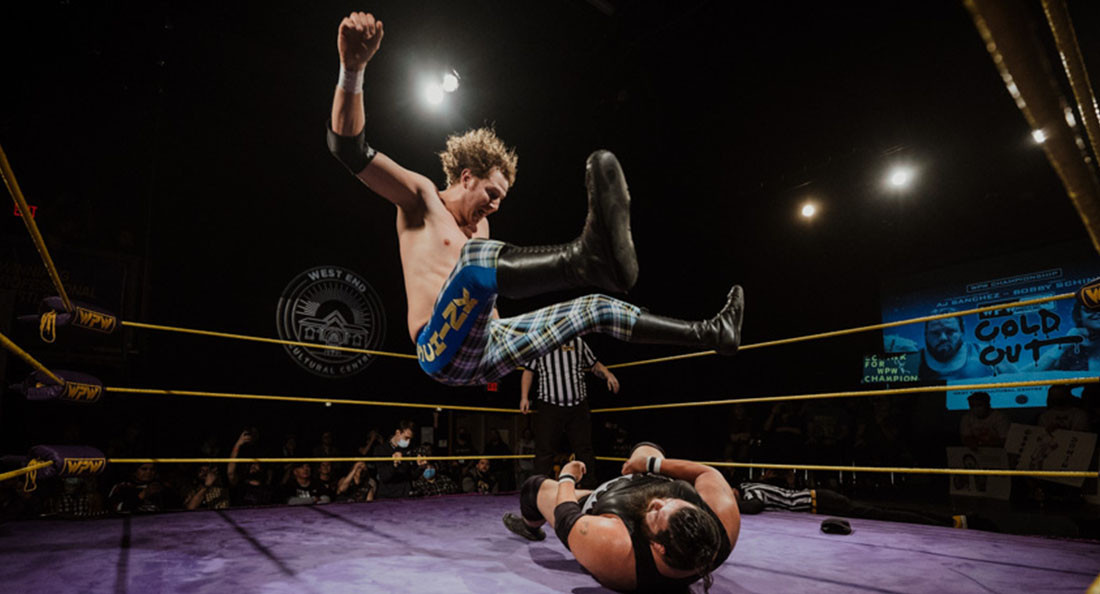Reinventing the ring
Winnipeg’s rich pro wrestling history pile-drives expectations
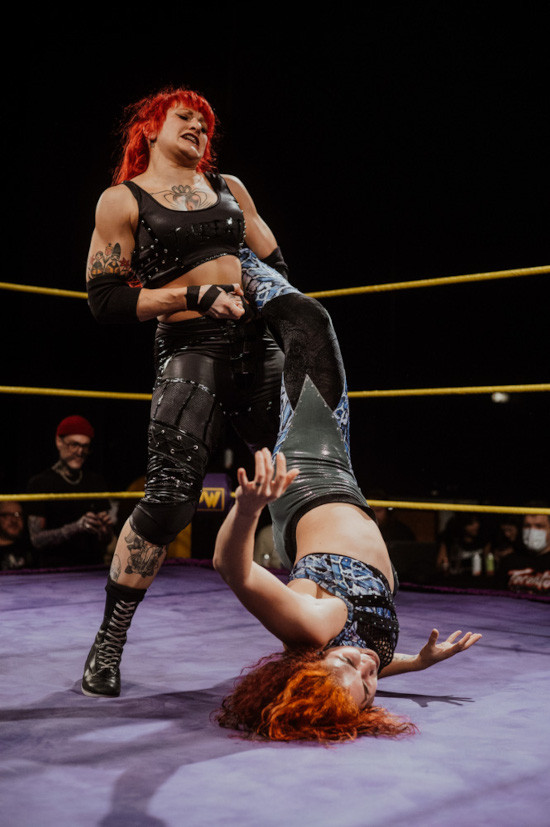
Jody Threat faces off against Masha Slamovich at a WPW event.
Attending your first professional wrestling match is a bit like attending a Rocky Horror Picture Show screening.
You have to see it live. You can never fully anticipate it. And, often, it’s best to go in blind.
On a weekday evening, a standard Winnipeg entertainment venue is transformed into a semi-fictional world composed of wrestlers, announcers, referees – and, of course, fans.
As competitors hailing from Manitoba and beyond take the stage, a series of wrestler-specific chants and affectionate profanities ensue.
It’s hard to explain the allure of wrestling without being around the ring. Yet, in talking to wrestling fans across the city, there’s a strange phenomenon at play: those who never expect to enjoy wrestling find themselves scrambling to book tickets to the next show.
Colin Harrison, 60, knows this well. Ever since he attended a match at the bygone Winnipeg Arena at 10 years old, he’s been hooked.
“My mom and dad used to go to wrestling well before (that). I think my mom said I was in her tummy. She was eight months pregnant, going to wrestling matches,” he says. “Even back then, wrestling was a big thing.”
Harrison has passed on a familial love of wrestling to his son Spencer. Since venues reopened after pandemic lockdowns, Harrison reckons they’ve attended more than 40 shows together – and don’t plan to stop anytime soon.
Somewhere between and beyond the realm of theatre and sport, wrestling has garnered a dedicated and increasingly diverse fanbase.
In Winnipeg, there are a growing number of converts. After Winnipeg Pro Wrestling (WPW), a promotion that prides itself on inclusion and outof- the-box thinking, emerged in 2018, co-owner Devin Bray says venues began selling out at turbo speed. Fans typically less-represented in wrestling crowds – namely, women – began to disrupt the audience ratio.
Long before its 2020s resurgence, professional wrestling found a home in Manitoba haunts as early as the late 1800s. Throughout its storied history, it’s drawn in the blue-collared and elite alike. It’s where divides soften and alliances are tested. It’s both fantasy and reality.
“Wrestling isn’t part of this world,” Bray says. “It’s kind of a refuge from this world, like a replacement for it.”
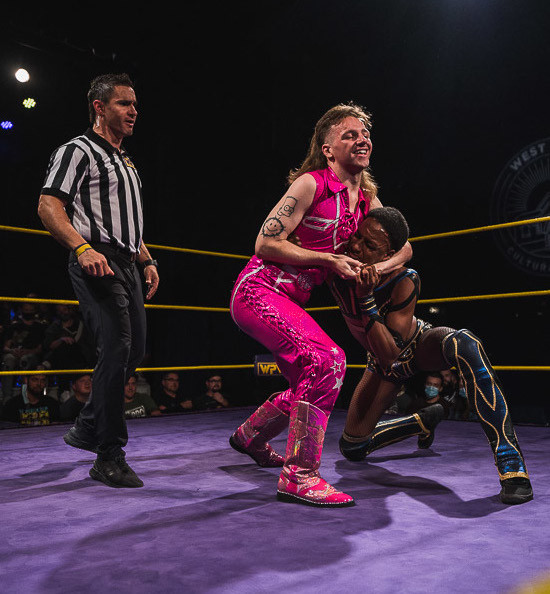
"The Rhinestone Cowboy" Steven Crowe grapples with "Black Sexcellence" Devon Monroe.
Historical roots of wrestling in Manitoba
In his book Thrashing Seasons, historian C. Nathan Hatton chronicles a wrestling event on April 3, 1923, where around 2,000 people gathered at Winnipeg’s Industrial Exhibition Building.
An assortment of accents and fashions huddled under electric lamplight to see the action in the ring.
“Many in attendance, however, wore more than their clothing that night. They wore their identities,” Hatton writes. “The combative spectacle that they were about to witness was symbolic of greater conflicts being waged on the factory floors and in the streets, community halls, immigrant sheds, and boarding rooms throughout a city where ethnic and class divisions shaped the fabric of daily existence.”
The historical roots of professional wrestling in Manitoba can be traced back to the construction boom of the early 1880s, where it often took place at variety theatres. True to their namesake, these theatres offered a rotating menu of burlesque, song and, of course, wrestling.
As Hatton argues, the evolution of professional wrestling in Winnipeg is intricately linked to the cultural and social transformations taking place in the central Prairies. Immigrant communities of the time nurtured their own stars.
“Very often, you’d have wrestlers of one ethnicity who would be pitted against others,” Hatton says over the phone. “The Scandinavian community was represented by folks like Charles Gustafson, who was a Swedish immigrant, and then you had, of course, Franco-Manitobans who were represented by people like Pete or Pierre Menard, and in the Polish community, there were the Sielski brothers.”
By the 1960s, major promotions like the American Wrestling Association began booking shows in Winnipeg. In the ’70s, it exploded into a televised frenzy, airing as a weekly program on CKND (now branded as Global Winnipeg).
After bearing witness to half a century of Winnipeg’s wrestling evolution, Harrison believes it’s experiencing a resurgence. In the last five years, WWE has made several trips to Winnipeg, including a televised event in February 2020. However, outside of the Canada Life Centre, indie promotions are drumming up interest and selling out locales across the city.
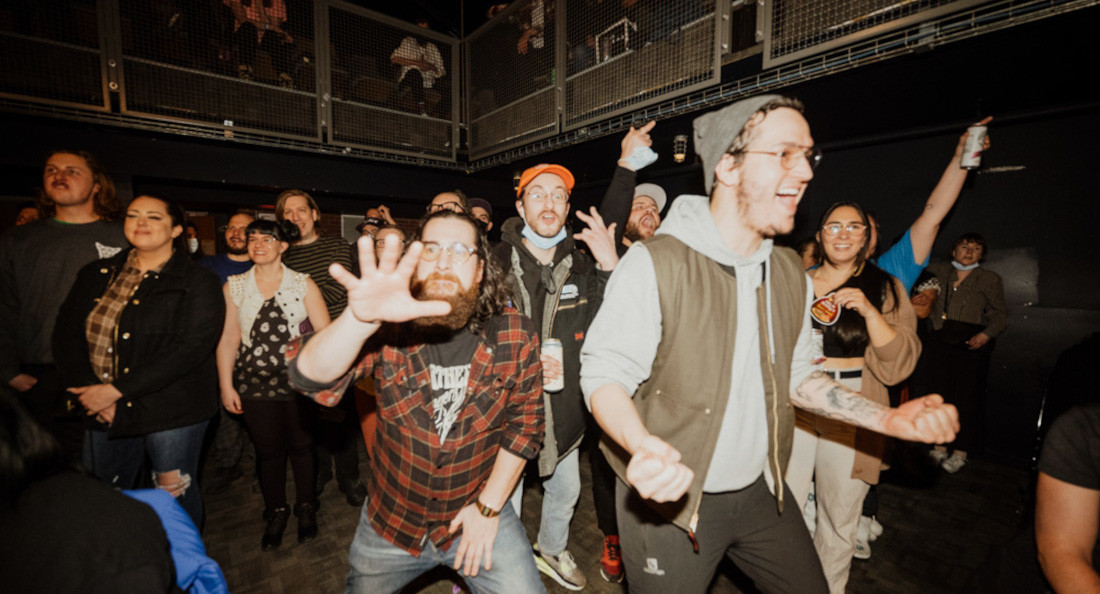
Spectators cheering during WPW Cold Out 2023, when Bobby Schink won the WPW Championship against AJ Sanchez.
The birth of WPW
In 2018, a new wrestling promotion was born from a few lifelong fans who wanted to bring something different to the scene.
Rounding up a roster of local talent, co-founders Devin Bray, Ben Kissock, TJ Stevenson, Adam Giardino and James Korba booked the first WPW throw-down at the Sherbrook Inn in December of that year.
“We always knew that we wanted to be something sort of outside of the box and present wrestling in a different light than it maybe had in the past in Winnipeg,” Bray says.
Soon, the indie wrestling league attracted far more fans than they could fit in the Sherb. After scouting the West End Cultural Centre (WECC) as their new home base, they turned their growing pains into gains.
Though, it wasn’t without challenges. The promotion booked its first WECC show in March 2020, just as COVID-19 found its way to Manitoba. Its anticipated expansion was put on hold.
After the city’s entertainment venues began to reopen to the public, it didn’t take long for WPW’s events to attract a dedicated fanbase. In the past two years, they’ve programmed matches at the Manitoba Museum, ManyFest and the Burton Cummings Theatre, in addition to their regular schedule at the WECC.
In his 14 years in the local scene, wrestler Tyler Sigurdson, known as Tyler Colton in the ring, says WPW has attracted an unprecedented amount of attention to wrestling in Winnipeg in just a few years.
“All of a sudden, these shows that are happening in Winnipeg are much more of a hot ticket,” he says. “There’s kind of been ebbs and flows of wrestling becoming very popular in Winnipeg but definitely never anything like we see right now. These guys sell their shows out within hours of announcing them.”
He likens their success to two factors: knowing their audience well and attracting new fans by bringing something different to the table.
“It’s bringing in people that we’ve never really seen at wrestling shows before,” Sigurdson says. “There have always been women in the crowd, but I don’t think there’s been as many as we see now. It’s getting pretty close to a 50/50 split between men and women in the crowd, and it’s nice to see.”
As one of the most beloved characters in the Winnipeg wrestling scene, Andrew Schinkel, who goes by Sweet Bobby Schink, is known for his natural charisma and signature, syrupy move: taking performance-enhancing swigs of Canadian maple.
When preparing for a match, Schinkel keeps it simple.
“Obviously, you want to get the body looking good. It’s show business, right?” he says. “You think about it, you talk about it, and you go out there and give the fans a hell of a show.”
Like many wrestlers, Schinkel leads somewhat of a double life between weekdays and weekends. A seasonal rotation of landscaping and snow-removal gigs keeps him busy during the week before prepping for a weekend on the road.
“Pretty much almost every weekend, I travel all around Manitoba through Saskatchewan to Alberta,” he says. “Sometimes you’ll get a couple, two (or) three shows in a weekend. Other weekends, you might get one show. It all depends.”
What sets professional wrestling apart from other forms of competitive wrestling is kayfabe, the principle of accepting the staged nature of the show as real.
Over the years, WPW didn’t only expand into new venues – they expanded their world, too. Their staple staff of announcers and referees expanded to include drag-queen hosts and commentators giving live updates.
In wrestling, worldbuilding constitutes the subtle, behind-the-scenes work to keep fans buying into what they present and lure them into another match. The key is balance and, as Bray describes, a “save-the-cat moment” for the heroes. “It’s kind of a double-edged sword. I want to book a show where people have a good time, but you don’t just want to always have a happy ending every show,” Bray says. “If the hero is always coming out on top and there’s not much adversity, there’s not much reason to get behind them.”
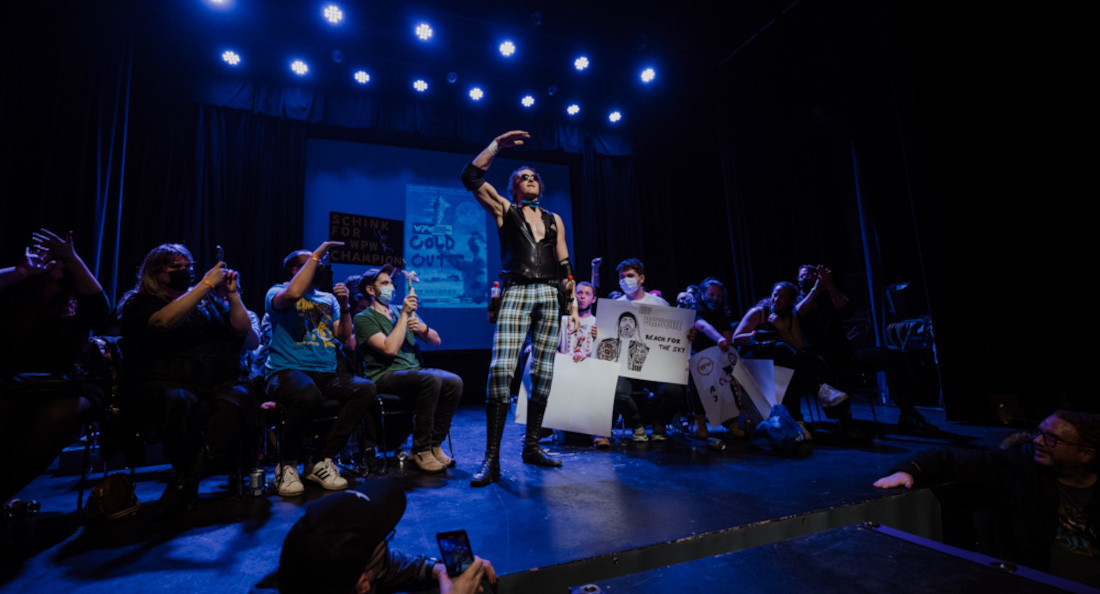
Bobby Schink approaches the ring at WPW Out Cold 2023.
Bringing the heat, despite the cold
For nearly 150 years, professional wrestling has found an enduring home in Winnipeg. As a historically and presently multicultural city, Hatton believes Manitobans are geographically primed to enjoy wrestling.
“It touches a lot of the key points that interest a multicultural city like Winnipeg,” he says. “You’ve got elements of nationalism that are being played up in the ring, sometimes anti-American sentiment being played up in the ring, which has always been a significant element of Canadian history.”
The rest comes down to having great homegrown talent – something Winnipeg has been blessed with for more than a hundred years, Hatton says.
Beyond all the essential elements of putting on a good show, it’s about mirroring your audience. To entice a new crowd, you have to get people they can get behind – and even relate to – in the ring.
“The audience wants to see themselves reflected in the athletes that are competing,” Bray says. “The women in the crowd want to see women performing and get behind them and not see it treated as such a novelty (but) see it treated like a serious athletic competition.”
After 50 years of attending shows, Harrison has gleaned a fundamental truth about wrestling.
“You gotta come to a show,” he says. “People can’t believe it ‘til they see it themselves.”
In the ring and across the stands, wrestling embodies the heart and stomach of the city. It’s a projection of the audience’s fears and desires, a place where profanities are words of endearment and a reflection of a locale’s diversity and unity.
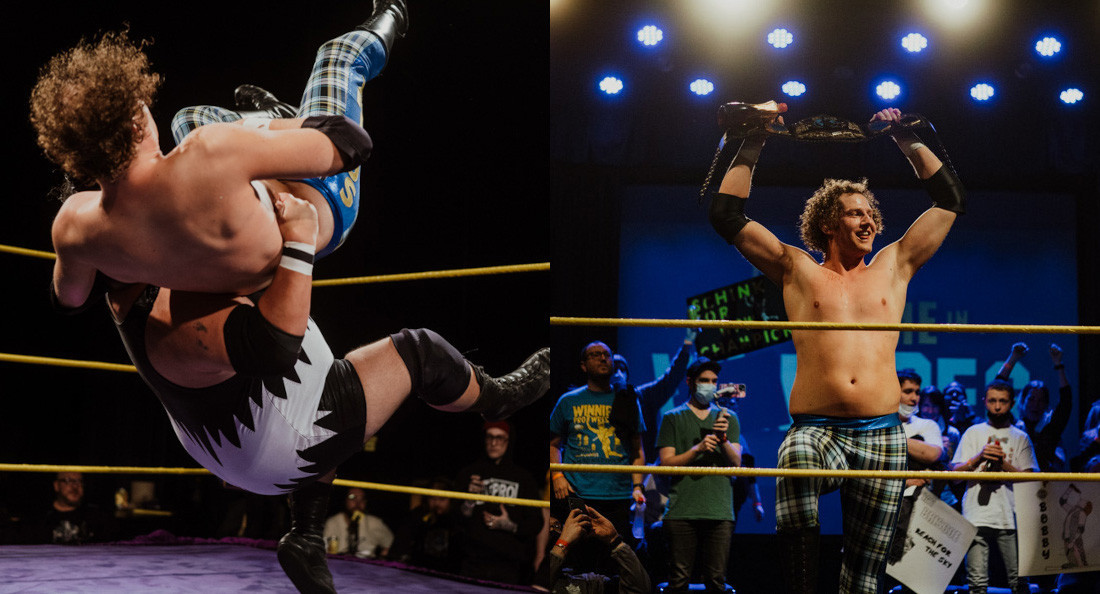
Left: AJ Sanchez suplexes Schink. Right: Schink emerges victorious.
Published in Volume 78, Number 15 of The Uniter (January 25, 2024)

